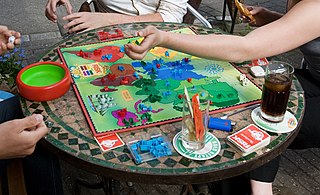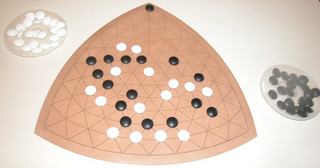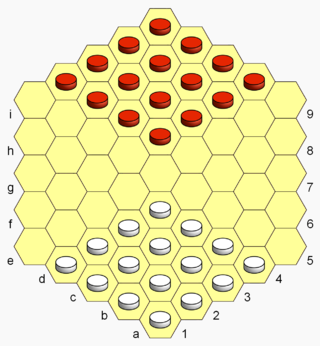
Gomoku, also called Five in a Row, is an abstract strategy board game. It is traditionally played with Go pieces on a 15×15 Go board while in the past a 19×19 board was standard. Because pieces are typically not moved or removed from the board, gomoku may also be played as a paper-and-pencil game. The game is known in several countries under different names.

Risk is a strategy board game of diplomacy, conflict and conquest for two to six players. The standard version is played on a board depicting a political map of the world, divided into 42 territories, which are grouped into six continents. Turns rotate among players who control armies of playing pieces with which they attempt to capture territories from other players, with results determined by dice rolls. Players may form and dissolve alliances during the course of the game. The goal of the game is to occupy every territory on the board and, in doing so, eliminate the other players. The game can be lengthy, requiring several hours to multiple days to finish. European versions are structured so that each player has a limited "secret mission" objective that shortens the game.

Fanorona is a strategy board game for two players. The game is indigenous to Madagascar.

Checkers, also known as draughts, is a group of strategy board games for two players which involve forward movements of uniform game pieces and mandatory captures by jumping over opponent pieces. Checkers is developed from alquerque. The term "checkers" derives from the checkered board which the game is played on, whereas "draughts" derives from the verb "to draw" or "to move".

Go is an abstract strategy board game for two players in which the aim is to capture more territory than the opponent by fencing off empty space. The game was invented in China more than 2,500 years ago and is believed to be the oldest board game continuously played to the present day. A 2016 survey by the International Go Federation's 75 member nations found that there are over 46 million people worldwide who know how to play Go, and over 20 million current players, the majority of whom live in East Asia.

The rules of Go have seen some variation over time and from place to place. This article discusses those sets of rules broadly similar to the ones currently in use in East Asia. Even among these, there is a degree of variation.

Havannah is a two-player abstract strategy board game invented by Christian Freeling. It belongs to the family of games commonly called connection games; its relatives include Hex and TwixT. Havannah has "a sophisticated and varied strategy" and is best played on a base-10 hexagonal board, 10 hex cells to a side.

Y is an abstract strategy board game, first described by John Milnor in the early 1950s. The game was independently invented in 1953 by Craige Schensted and Charles Titus. It is a member of the connection game family inhabited by Hex, Havannah, TwixT, and others; it is also an early member in a long line of games Schensted has developed, each game more complex but also more generalized.

Christian Freeling is a Dutch game designer and inventor of abstract strategy games, notably Dameo, Grand Chess, Havannah, and Hexdame.

Rummikub is a tile-based game for 2 to 4 players, combining elements of the card game rummy and mahjong. There are 106 tiles in the game, including 104 numbered tiles and two jokers. Players have 14 or 16 tiles initially and take turns putting down tiles from their racks into sets of at least three, drawing a tile if they cannot play. In the Sabra version, the first player to use all their tiles scores a positive score based on the total of the other players' hands, while the losers get negative scores. Variations of the game contain four jokers. An important feature of the game is that players can move and reuse the tiles that have already been placed on the table.

There are many variations of the simple rules of Go. Some are ancient digressions, while other are modern deviations. They are often side events at tournaments, for example, the U.S. Go Congress holds a "Crazy Go" event every year.

Turkish draughts (Armenian: շաշկի)(Arabic: دامە)(Kurmanji: Dame) is a variant of draughts (checkers) played in Turkey, Greece, Egypt, Kuwait, Lebanon, Syria, Jordan and several other locations around the Mediterranean Sea and Middle East.

Armenian draughts, or Tama, is a variant of draughts played in Armenia. The rules are similar to Dama. Armenian draughts, however, allows for diagonal movement.
A connection game is a type of abstract strategy game in which players attempt to complete a specific type of connection with their pieces. This could involve forming a path between two or more endpoints, completing a closed loop, or connecting all of one's pieces so they are adjacent to each other. Connection games typically have simple rules, but complex strategies. They have minimal components and may be played as board games, computer games, or even paper-and-pencil games.

Emergo is an abstract strategy game created by Christian Freeling and Ed van Zon in 1986. It belongs to the "stacking" category of games, or column checkers, along with Bashni and Lasca. The name comes from the motto of the Dutch province of Zeeland: Luctor et emergo meaning: "I wrestle and emerge". The goal of the game is to capture all of the opponents pieces similar to checkers/draughts. Emergo, and all column checkers, differ from most draughts variants because of their unique method of capture. An opponent's piece is added to the capturing player's column rather than being removed. Men can be recaptured from an opponent later on in the game.

Dragonfly is a chess variant invented by Christian Freeling in 1983. There are no queens, and a captured bishop, knight, or rook becomes the property of the capturer, who may play it as their own on a turn to any open square. The board is 7×7 squares, or alternatively a 61-cell hexagon with two additional pawns per side.

Hexdame is a strategy board game for two players invented by Christian Freeling in 1979. The game is a literal adaptation of the game international draughts to a hexagonal gameboard.

Dameo is an abstract strategy board game for two players invented by Christian Freeling in 2000. It is a variant of the game draughts and is played on an 8×8 checkered gameboard.

Congo is a chess variant invented by Demian Freeling in 1982 when he was nearly 8 years old. His father encouraged him to design a variant using a 7×7 gameboard. Demian was already familiar with chess and xiangqi, and the result blends some features from both. Congo became the second-most popular chess variant at the Fanaat games club in Enschede, the Netherlands.

Sygo is a two player abstract strategy game created in 2010 by Christian Freeling. It is a variant of Go. Sygo is played on a 19x19 grid of lines. It differs from Go in that captured stones change colors instead of being removed from the board, similar to Reversi/Othello. Additionally, each turn, players may either place a new stone, or else grow all of their existing groups of stones by placing a new stone adjacent to each group, similar to Symple, another of Christian Freeling's games. The goal of Sygo is to control the most territory on the board as determined by the number of a player's stones on the board as well as empty points surrounded by the players stones. The game ends either when one player resigns or both players pass on successive turns.

















